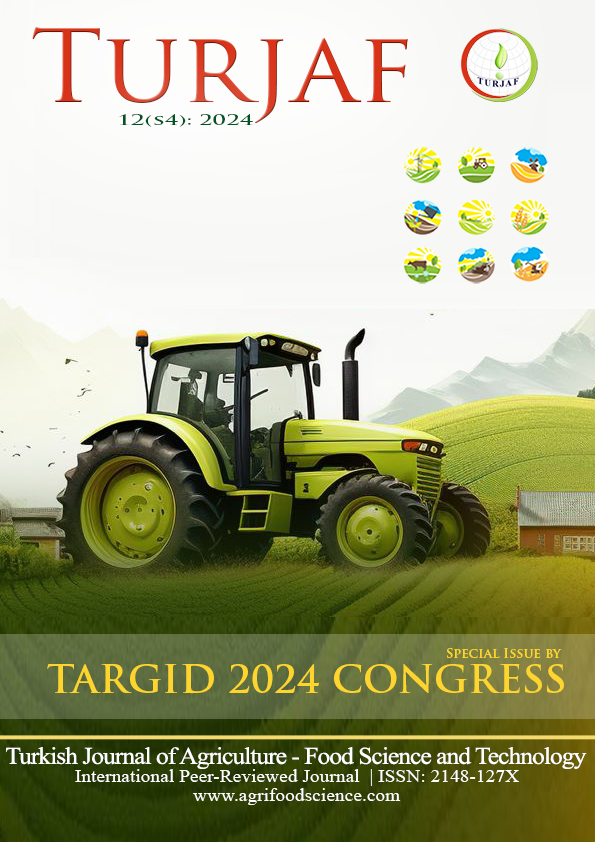Phytochemical Analysis and Antibacterial Effects of Anastatica hierochuntica Extracts on Foodborne and Clinical Pathogens
DOI:
https://doi.org/10.24925/turjaf.v12is4.2901-2906.7288Keywords:
Anastatica hierochuntica, Phytochemical screening, Food pathogens, Clinical isolates, Plant extracts, AntioxidantsAbstract
This study explores the phytochemical composition and antibacterial properties of aqueous and methanolic extracts of Anastatica hierochuntica against foodborne pathogens and clinical isolates. Phytochemical analysis identified key compounds, including alkaloids (7.15 ± 0.0365 mg/g), flavonoids (3.16 ± 0.007 mg/g), and tannins (0.18 ± 0.0025 mg/g). Food samples yielded Escherichia coli isolates, Staphylococcus aureus, Staphylococcus epidermidis, Salmonella typhi, and Serratia marcescens. The antibacterial efficacy was assessed using the agar well diffusion method against these pathogens and clinical isolates, including Pseudomonas aeruginosa and Klebsiella pneumoniae. The aqueous extract demonstrated strong antibacterial activity against all food pathogens, with Staphylococcus aureus, Salmonella typhi, and Serratia marcescens exhibiting the largest inhibitory zones (34 mm). Among clinical isolates, only Klebsiella pneumoniae and Pseudomonas aeruginosa showed selective inhibition. Conversely, the methanolic extract was largely ineffective, displaying activity only against Serratia marcescens (average inhibitory zone of 11.7 mm). These results underscore the potential of A. hierochuntica aqueous extracts as a natural antimicrobial agent and suggest further investigation into its bioactive compounds for improving food safety and addressing multidrug-resistant pathogens.
References
Abd-elmegeed, A. S. S., saad Abd-alrahman, H., Mohamed, A. A., & Ghaber, B. M. (2023). Biological properties and identification of some active ingredients in Anastatica hierochuntica and Lepidium sativum, grown in Egypt. International Journal of Science and Research Archive, 10(1), 435-445.
Amenu, D. (2014). Antimicrobial activity of medicinal plant extracts and their synergistic effect on some selected pathogens. American Journal of Ethnomedicine, 1(1), 18–29. https://doi.org/10.52589/AJEMJ3A1X
Badr, M. M., & Quiroz, I. V. (2024). Antimicrobial effect of natural products against bacteria, fungi, and yeasts. In Biotechnology and Drug Development for Targeting Human Diseases (pp. 137–164).
Bakir Çilesizoğlu N., Yalçin Çavuşoğlu E., Cavusoglu k., Kuloglu Sipahi S. (2022). Qualitative and quantitative phytochemical screening of Nerium oleander L. extracts associated with toxicity profile. Sci Rep 12, 21421 .https://doi.org/10.1038/s41598-022-26087-0
Bhattacharjee, B., & Islam, S. S. (2015). Assessment of antibacterial and antifungal activities of the extracts of Rhynchostylis retusa Blume—a medicinal orchid. World Journal of Pharmacy and Pharmaceutical Sciences, 4(2), 74–8
Guo, H., Diao, Q.-P., Hou, D.-Y., Li, Z.-H., Zhou, Z.-Y., Feng, T., & et al. (2017). Sesquiterpenoids from cultures of the edible mushroom Craterellus cornucopioides. Phytochemistry Letters, 21, 114–117. https://doi.org/10.1016/j.phytol.2017.07.013
Ihsanullah, D. (2012). Chemical properties of the medicinal herb Kaff Maryam (Anastatica hierochuntica L.) and its relation to folk medicine use. African Journal of Microbiology Research, 6(23), 5048–5051. https://doi.org/10.5897/AJMR12.1694
Kiran, B. R., & Venkata Mohan, S. (2021). Microalgal cell biofactory therapeutic, nutraceutical and functional food applications. Plants, 10(5), 836. https://doi.org/10.3390/plants10050836
Lyubitelev, A., & Studitsky, V. (2023). Inhibition of cancer development by natural plant polyphenols: Molecular mechanisms. International Journal of Molecular Sciences, 24(13), 10663. https://doi.org/10.3390/ijms241310663
Masoko, P. (2017). Phytochemical analysis, antioxidant and antibacterial properties of Spilanthes mauritiana used traditionally in Limpopo Province, South Africa. Journal of Evidence-Based Complementary & Alternative Medicine, 22(4), 936–943. https://doi.org/10.1177/2156587217704698
Pareek, A., Pant, M., Gupta, M. M., Kashania, P., Ratan, Y., Jain, V., & et al. (2023). Moringa oleifera: An updated comprehensive review of its pharmacological activities, ethnomedicinal, phytopharmaceutical formulation, clinical, phytochemical, and toxicological aspects. International Journal of Molecular Sciences, 24(3), 2098. https://doi.org/10.3390/ijms24032098
Pires, S. M., Redondo, H. G., Pessoa, J., Jakobsen, L. S., & Thomsen, S. T. (2024). Risk ranking of foodborne diseases in Denmark: Reflections on a national burden of disease study. Food Control, 158, 110199 . https://doi.org/10.1016/j.foodcont.2024.110199
Quinto, E. J., Caro, I., Villalobos-Delgado, L. H., Mateo, J., De-Mateo-Silleras, B., & Redondo-Del-Río, M. P. (2019). Food safety through natural antimicrobials. Antibiotics, 8(4), 208. https://doi.org/10.3390/antibiotics8040208
Saleh, M. S., Jalil, J., Zainalabidin, S., Asmadi, A. Y., Mustafa, N. H., & Kamisah, Y. (2021). Genus Parkia: Phytochemical, medicinal uses, and pharmacological properties. International Journal of Molecular Sciences, 22(2), 618. https://doi.org/10.3390/ijms22020618
Sathiyaseelan, A., Saravanakumar, K., Mariadoss, A. V. A., & Wang, M. H. (2020). Biocompatible fungal chitosan encapsulated phytogenic silver nanoparticles enhanced antidiabetic, antioxidant and antibacterial activity. International Journal of Biological Macromolecules, 153, 63–71. https://doi.org/10.1016/j.ijbiomac.2020.02.096
Tavares, W. R., & Seca, A. M. (2018). The current status of the pharmaceutical potential of Juniperus L. metabolites. Medicines, 5(3), 81. https://doi.org/10.3390/medicines5030081
Wu-Wu, J. W. F., Guadamuz-Mayorga, C., Oviedo-Cerdas, D., & Zamora, W. J. (2023). Antibiotic resistance and food safety: Perspectives on new technologies and molecules for microbial control in the food industry. Antibiotics, 12(3), 550. https://doi.org/10.3390/antibiotics12030550
Downloads
Published
How to Cite
Issue
Section
License
This work is licensed under a Creative Commons Attribution-NonCommercial 4.0 International License.









